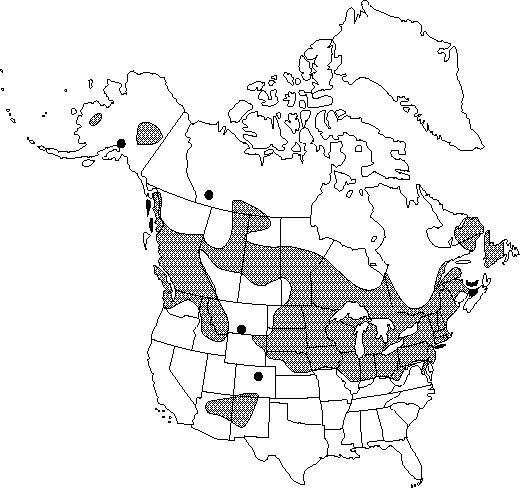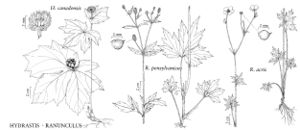Difference between revisions of "Ranunculus pensylvanicus"
Suppl. Pl., 272. 1782.
FNA>Volume Importer |
GeoffLevin (talk | contribs) m (Fixed Nfld. and Labr. distribution to match map in printed version.) |
||
| (8 intermediate revisions by 2 users not shown) | |||
| Line 13: | Line 13: | ||
}}{{Treatment/ID/Special_status | }}{{Treatment/ID/Special_status | ||
|code=F | |code=F | ||
| − | |label= | + | |label=Illustrated |
}} | }} | ||
|basionyms= | |basionyms= | ||
| Line 24: | Line 24: | ||
}}<!-- | }}<!-- | ||
| − | --><span class="statement" id="st- | + | --><span class="statement" id="st-undefined" data-properties=""><b>Stems </b>erect, never rooting nodally, hispid, base not bulbous. <b>Roots</b> never tuberous. <b>Basal</b> leaf blades broadly cordate in outline, 3-foliolate, 1.6-7 × 3-9 cm, leaflets cleft, usually deeply so, ultimate segments narrowly elliptic, margins toothed, apex acute. <b>Flowers</b>: receptacle hirsute; sepals reflexed ca. 1 mm above base, 3-5 × 1.5-2 mm, ± hispid; petals 5, yellow, 2-4 × 1-2.5 mm. <b>Heads</b> of achenes cylindric, 9-12 × 5-7 mm; achenes 1.8-2.8 × 1.6-2 mm, glabrous, margin forming narrow rib 0.1-0.2 mm wide; beak persistent, broadly lanceolate or nearly deltate, straight or nearly so, 0.6-0.8 mm. <b>2n</b> = 16.</span><!-- |
-->{{Treatment/Body | -->{{Treatment/Body | ||
| Line 30: | Line 30: | ||
|habitat=Stream banks, bogs, moist clearings, depressions in woodlands | |habitat=Stream banks, bogs, moist clearings, depressions in woodlands | ||
|elevation=0-1700 m | |elevation=0-1700 m | ||
| − | |distribution=Alta.;B.C.;Man.;N.B.;Nfld.;N.W.T.;N.S.;Ont.;P.E.I.;Que.;Sask.;Alaska;Ariz.;Colo.;Conn.;Del.;D.C.;Idaho;Ill.;Ind.;Iowa;Maine;Md.;Mass.;Mich.;Minn.;Mont.;Nebr.;N.H.;N.J.;N.Mex.;N.Y.;N.Dak.;Ohio;Pa.;R.I.;S.Dak.;Vt.;Wash.;W.Va.;Wis.;Wyo. | + | |distribution=Alta.;B.C.;Man.;N.B.;Nfld. and Labr.;N.W.T.;N.S.;Ont.;P.E.I.;Que.;Sask.;Alaska;Ariz.;Colo.;Conn.;Del.;D.C.;Idaho;Ill.;Ind.;Iowa;Maine;Md.;Mass.;Mich.;Minn.;Mont.;Nebr.;N.H.;N.J.;N.Mex.;N.Y.;N.Dak.;Ohio;Pa.;R.I.;S.Dak.;Vt.;Wash.;W.Va.;Wis.;Wyo. |
| − | |discussion=<p>Ojibwa tribes used Ranunculus pensylvanicus as a hunting medicine; the Potawatomi used it as an astringent for miscellaneous diseases (D. E. Moerman 1986).</p> | + | |discussion=<p>Ojibwa tribes used <i>Ranunculus pensylvanicus</i> as a hunting medicine; the Potawatomi used it as an astringent for miscellaneous diseases (D. E. Moerman 1986).</p> |
|tables= | |tables= | ||
|references= | |references= | ||
| Line 40: | Line 40: | ||
-->{{#Taxon: | -->{{#Taxon: | ||
name=Ranunculus pensylvanicus | name=Ranunculus pensylvanicus | ||
| − | |||
|authority=Linnaeus f. | |authority=Linnaeus f. | ||
|rank=species | |rank=species | ||
| Line 50: | Line 49: | ||
|habitat=Stream banks, bogs, moist clearings, depressions in woodlands | |habitat=Stream banks, bogs, moist clearings, depressions in woodlands | ||
|elevation=0-1700 m | |elevation=0-1700 m | ||
| − | |distribution=Alta.;B.C.;Man.;N.B.;Nfld.;N.W.T.;N.S.;Ont.;P.E.I.;Que.;Sask.;Alaska;Ariz.;Colo.;Conn.;Del.;D.C.;Idaho;Ill.;Ind.;Iowa;Maine;Md.;Mass.;Mich.;Minn.;Mont.;Nebr.;N.H.;N.J.;N.Mex.;N.Y.;N.Dak.;Ohio;Pa.;R.I.;S.Dak.;Vt.;Wash.;W.Va.;Wis.;Wyo. | + | |distribution=Alta.;B.C.;Man.;N.B.;Nfld. and Labr.;N.W.T.;N.S.;Ont.;P.E.I.;Que.;Sask.;Alaska;Ariz.;Colo.;Conn.;Del.;D.C.;Idaho;Ill.;Ind.;Iowa;Maine;Md.;Mass.;Mich.;Minn.;Mont.;Nebr.;N.H.;N.J.;N.Mex.;N.Y.;N.Dak.;Ohio;Pa.;R.I.;S.Dak.;Vt.;Wash.;W.Va.;Wis.;Wyo. |
|reference=None | |reference=None | ||
|publication title=Suppl. Pl., | |publication title=Suppl. Pl., | ||
|publication year=1782 | |publication year=1782 | ||
| − | |special status=Endemic; | + | |special status=Endemic;Illustrated |
| − | |source xml=https:// | + | |source xml=https://bitbucket.org/aafc-mbb/fna-data-curation/src/2e0870ddd59836b60bcf96646a41e87ea5a5943a/coarse_grained_fna_xml/V3/V3_84.xml |
|genus=Ranunculus | |genus=Ranunculus | ||
|subgenus=Ranunculus subg. Ranunculus | |subgenus=Ranunculus subg. Ranunculus | ||
|section=Ranunculus sect. Ranunculus | |section=Ranunculus sect. Ranunculus | ||
|species=Ranunculus pensylvanicus | |species=Ranunculus pensylvanicus | ||
| − | |||
| − | |||
| − | |||
| − | |||
| − | |||
| − | |||
| − | |||
| − | |||
| − | |||
| − | |||
| − | |||
| − | |||
| − | |||
| − | |||
| − | |||
| − | |||
| − | |||
| − | |||
| − | |||
| − | |||
| − | |||
| − | |||
| − | |||
| − | |||
| − | |||
| − | |||
| − | |||
| − | |||
| − | |||
| − | |||
| − | |||
| − | |||
| − | |||
| − | |||
| − | |||
| − | |||
}}<!-- | }}<!-- | ||
-->[[Category:Treatment]][[Category:Ranunculus sect. Ranunculus]] | -->[[Category:Treatment]][[Category:Ranunculus sect. Ranunculus]] | ||
Latest revision as of 17:08, 29 February 2024
Stems erect, never rooting nodally, hispid, base not bulbous. Roots never tuberous. Basal leaf blades broadly cordate in outline, 3-foliolate, 1.6-7 × 3-9 cm, leaflets cleft, usually deeply so, ultimate segments narrowly elliptic, margins toothed, apex acute. Flowers: receptacle hirsute; sepals reflexed ca. 1 mm above base, 3-5 × 1.5-2 mm, ± hispid; petals 5, yellow, 2-4 × 1-2.5 mm. Heads of achenes cylindric, 9-12 × 5-7 mm; achenes 1.8-2.8 × 1.6-2 mm, glabrous, margin forming narrow rib 0.1-0.2 mm wide; beak persistent, broadly lanceolate or nearly deltate, straight or nearly so, 0.6-0.8 mm. 2n = 16.
Phenology: Flowering late spring–summer (Jun–Aug).
Habitat: Stream banks, bogs, moist clearings, depressions in woodlands
Elevation: 0-1700 m
Distribution

Alta., B.C., Man., N.B., Nfld. and Labr., N.W.T., N.S., Ont., P.E.I., Que., Sask., Alaska, Ariz., Colo., Conn., Del., D.C., Idaho, Ill., Ind., Iowa, Maine, Md., Mass., Mich., Minn., Mont., Nebr., N.H., N.J., N.Mex., N.Y., N.Dak., Ohio, Pa., R.I., S.Dak., Vt., Wash., W.Va., Wis., Wyo.
Discussion
Ojibwa tribes used Ranunculus pensylvanicus as a hunting medicine; the Potawatomi used it as an astringent for miscellaneous diseases (D. E. Moerman 1986).
Selected References
None.
